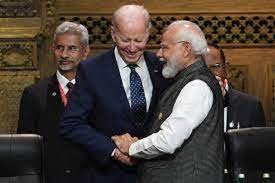There is much excitement over Prime Minister Narendra Modi’s State Visit to the United States next week. The Joe Biden administration is laying out the red carpet for the Indian PM. On 21 June, President Biden is hosting a state dinner for Prime Minister Modi. There is a ceremonial welcome the next day, as official talks begin at the White House. On 23 June, the Prime Minister will address a joint session of the US Congress. There will be a lunch hosted by Vice President Kamala Harris and Secretary of State Antony Blinken, plus there will be a community event and meetings with business, political leaders, as well as the Indian diaspora. This will be the third State Visit for an Indian leader to the US, the previous two being that of President S. Radhakrishnan in 1963 and then Dr Manmohan Singh in 2009. This will also be the second time that PM Modi will be addressing the US Congress, a rare honour. He is also the third world leader to be invited by President Biden. Beyond all the optics, there will be serious business in the areas of technology and defence. There is speculation that there will be an agreement on the manufacturing of GE engines in India. According to Atul Keshap, president of the US-India Business Council, the GE deal will have a “ripple effect across the US and Indian defence industries”, impacting India-US defence relationship in a positive way for four decades. It will be a major step towards further transfer of technology, something that has been denied to India all these years. India signing the foundational agreements with the US eased the path of India-US defence and strategic relationship, to a large extent, but transfer of technology has always been a problem, the reason why many in this country are not sure about getting into any deep defence relationship with the US, and have preferred Russia. But in a fast changing world—and now with the Russia-Ukraine war disrupting supply chains of spare parts in particular—India realises that it has to wean itself away from its dependence on Russian defence materiel. The process of decoupling from Russia has accelerated under Prime Minister Narendra Modi, with India diversifying the sourcing of defence equipment, and making at home. But even after this, Indian military’s dependence on Russian materiel is said to be in the range of 50-60%, which is huge. Seen from this perspective, the manufacturing of GE engines will open a window of opportunity for the Indian defence manufacturing sector. Prior to this, the deal to manufacture F16 fighter jets’ wings in India has given a boost to India’s defence manufacturing industry, but the GE deal is much bigger. According to media reports, it involves the 100% transfer of technology for manufacturing GE’s F-414 engine. Apparently, the State Department, which has a history of being anti-India, raised objections to any such transfer. However, it got overruled by the Pentagon and the National Security Council headed by NSA Jake Sullivan, proving that US policymaking on India is coming out of the grip of the State Department. The GE deal’s importance can be gauged from the fact that the US has not shared this engine making technology with any country till date. Media reports say that there is also the possibility of the signing of a deal for US-made MQ-9B SeaGuardian armed drones that India may buy. Discussions are also likely to take place about the co-production of armoured personnel carriers, etc.
NSAs Ajit Doval and Jake Sullivan met in Washington on 31 January 2023 to discuss greater cooperation in the initiative on Critical and Emerging Technologies (iCET), which includes “co-development and coproduction”, and ways to “deepen connectivity” across the two nation’s “innovation ecosystems”, according to a White House readout. Apart from strengthening the innovation ecosystem, and enhancing defence innovation and technology cooperation, the two countries are looking at building a resilient semiconductor supply chain, which includes “supporting the development of a semiconductor design, manufacturing, and fabrication ecosystem in India” apart from the “development of a skilled workforce that will support global semiconductor supply chains and encourage the development of joint ventures and technology partnerships on mature technology nodes and packaging in India.”
This too is significant as the India-US partnership is going into areas where it has never gone before. The opportunities are immense and India needs to make the best of the situation, for its own growth trajectory.
Amid this, it is hoped that the State Department will drop its traditional “hostility” to India and facilitate the strengthening of India-US partnership, which is the most consequential of this century. By its needless needling of India all that the State does is to alienate public opinion here against the US—unless that is what the State’s intention is, to pamper China and rail against India. Lest we forget, the State Department is still making things difficult for Indians to get simple visitor visas to the US.
In the meanwhile, India looks forward to the PM’s visit to the US, as it is expected to have an immensely positive impact on India-US relations, while setting India on the path to higher growth and development.

















